Marking the 3rd anniversary of the magnificent Statue of Equality (216 feet tall statue of Swami Ramanujacharya) and 108 Divya Desams around it, the Brahmotsavams started in all fervour. As a precursor to this event, Vishwaksena puja, Punyaham and other related activities happened yesterday, 9th February. Today, the Brahmotsavams commenced amidst lot of cheer and festivities, with great devotion. Today also happens to be the day of Punarvasu star, the birth star of Lord Rama in Treta yuga. Here is a detailed report of today’s events.
The day started in a serene atmosphere at about 6 AM, where the devotees, scholars and vedic students assembled for morning prayers and meditation.
HH Chinna Jeeyar Swamiji gave guided all the assembled folks on how we prepare for doing meditation.
We purify our body, indriyas and manas by our thoughts and then prepare to start the meditation. This purification process has been explained in our scriptures. We start with a sankalpam, sit in a comfortable posture, place our right palm on top of
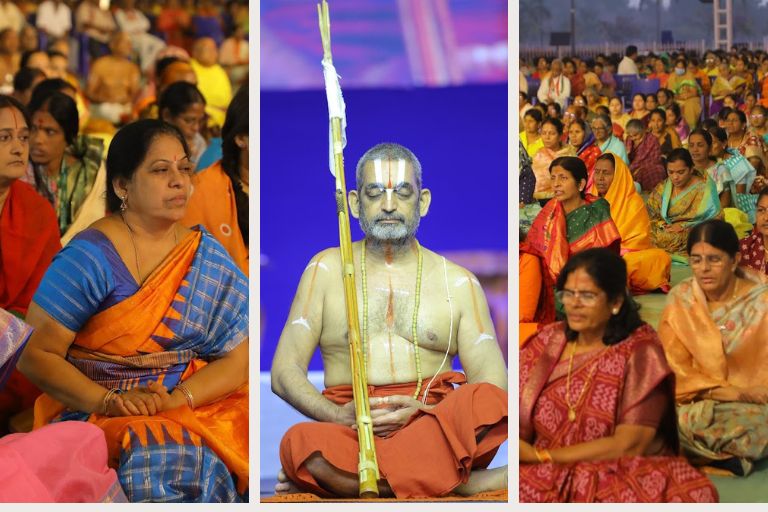
We purify our body, indriyas and manas by our thoughts and then prepare to start the meditation. This purification process has been explained in our scriptures. We start with a sankalpam, sit in a comfortable posture, place our right palm on top of left palm (both of them facing upwards) and keep chanting the nama at a slow pace in our mind. The number of times we chant is of no significance. What matters is that we chant the name of God with love and devotion. We visualize the embodiment of mantra, residing inside us – Lord Srimannarayana along with mother Lakshmi and His parivaram. He wakes up, cleanses us and receives our prayers / aradhana.
The God resides at our naval when we sleep. We awaken Him and bring him to our Hridayam / heart. He traverses upwards towards the head and again rests at naval when we sleep. It is a continuous process.
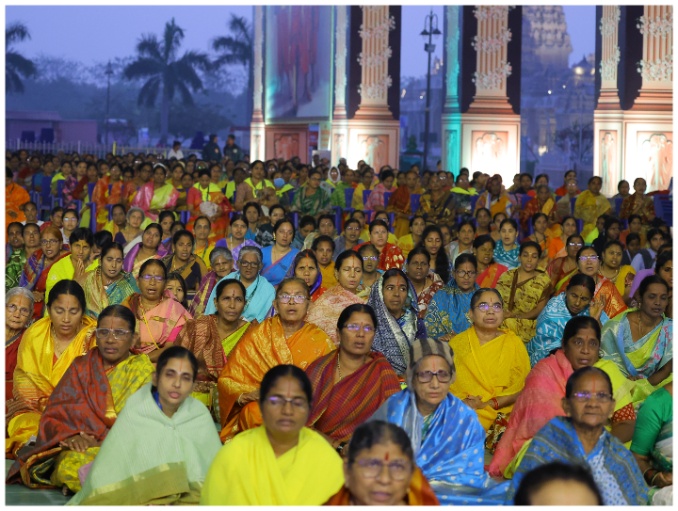
We visualize fire / Jyoti which starts at our naval and slowly pervades entire body. It purifies entire body by its power of burning down the internal doshas. We then imagine that a nice, cold stream of water originating from God showers us in entirety and refreshes us. After it dries out by the air of God’s grace again, the cycle then repeats – fire burning out the doshas of body, God’s grace in form of refreshing water showering us and again God’s grace in form of wind drying us out. We repeat this cycle three times in our mind.
First cycle clears the body, second cycle cleanses the indriyas and the third cycle purifies our manas and jnanam. We then assume the form of Sukshma sariram / miniature body. God carefully takes hold of this Sukshma sariram and traverses across the vast universe, crossing many spheres, planets, sun, etc. The scriptures say that there is a shell of liquid covering the entire universe, called ‘avarana jalam’. God makes us traverse those purifying waters too and brings us to the river Viraja. A person residing there touches us and gives us a new body, which is capable of entering God’s abode – parama padam.
We take a holy dip in a pushkarini there and get decorated by other dwellers of that place. Garuda then takes us to where God is seated. We climb up to the God though his feet. We emerge from God’s feet again completely purified.
The body that we possess at that moment is a completely new body, given by God. We again meditate on the God that is residing inside our hridayam along with his parivaram. We offer all services to God – like giving bath, offering food and giving him rest. We ask God to give us necessary strength and tools to continue our daily routines. We offer managalam to God and take an oath that we will lead the day today as Service to Himself. We then conclude our meditation / japam.
After the meditation session, Swamiji gave a brief outline of today’s scheduled events.
Devotees proceeded towards yaga sala. Morning prayers were offered.
Swamiji graced Teertha goshti to the assembled devotees after Aradhana.
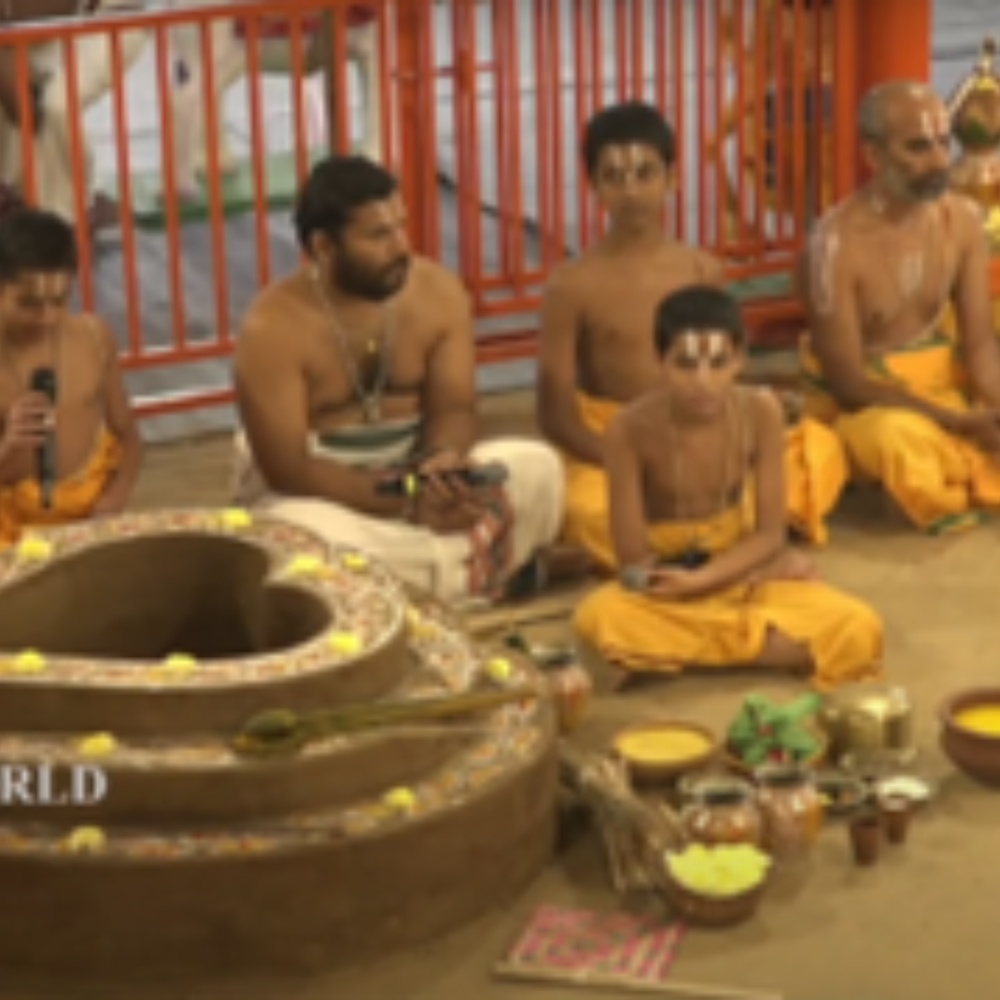
Morning prayers / Aradhana at yaga sala
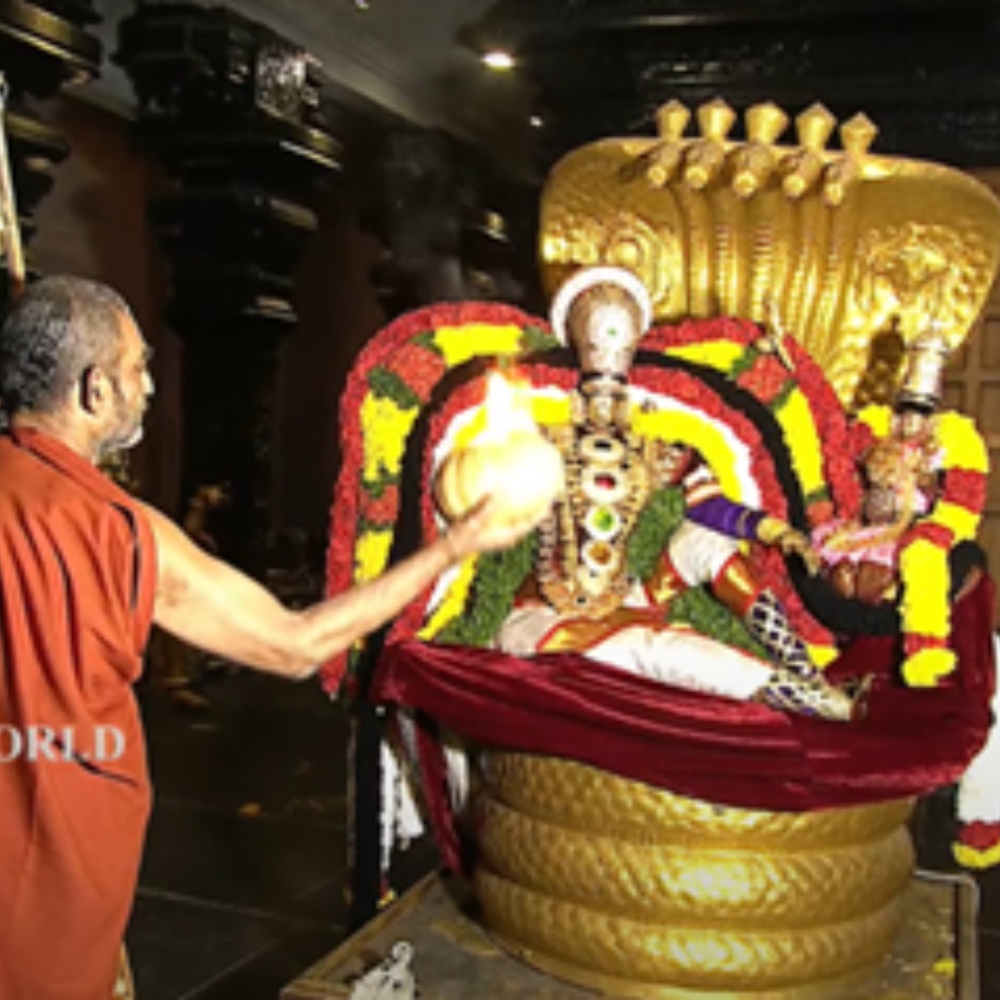
Seva kalam
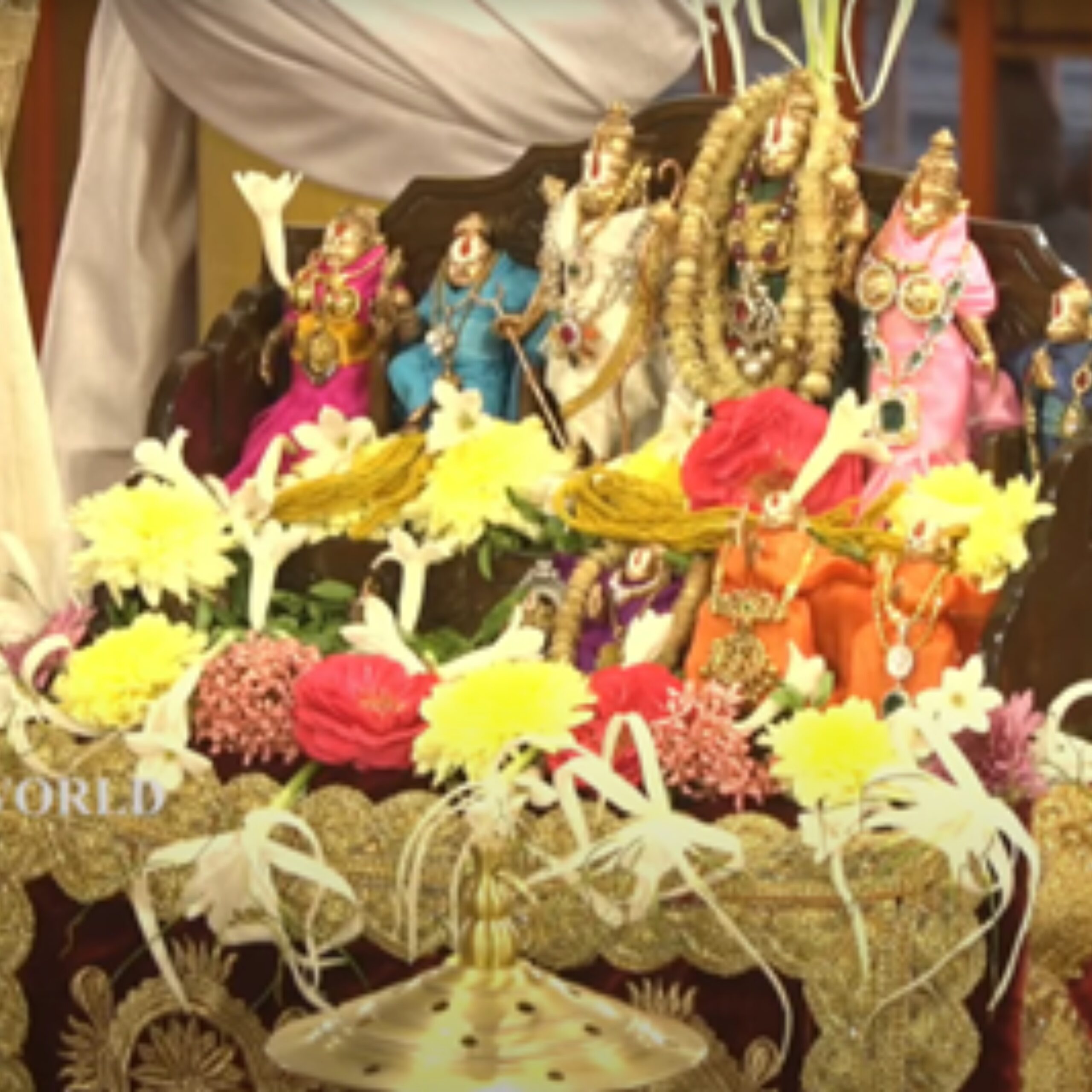
Lord Rama and parivaram accepting the morning prayers
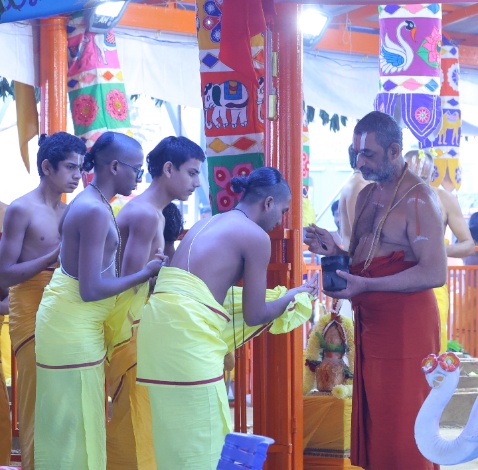
Teertha-goshti
Garuda patam (sacred cloth on which Garuda was painted) was prepared the previous day and worshipped in yaga sala. The rutwiks fetched that Garuda patam too.
The flag was offered prayers and was hoisted atop the flag post (dhwaja sthambham). Various devatas were invited through mantras. Different devatas have different ragams and thalams, using which they are invited.
The flag will rest atop this dhwaja sthambham for the entire duration of 9-days.
Garuda is embodiment of Vedas. Just as the final aim of Vedas is to give clarity about God, he always carries God and ensures the devotees get good clarity about God. In all Brahmotsavams, he is the one who is given the responsibility of inviting all the Devatas to the place of worship. In the form of a flag, he also identifies the place of worship.
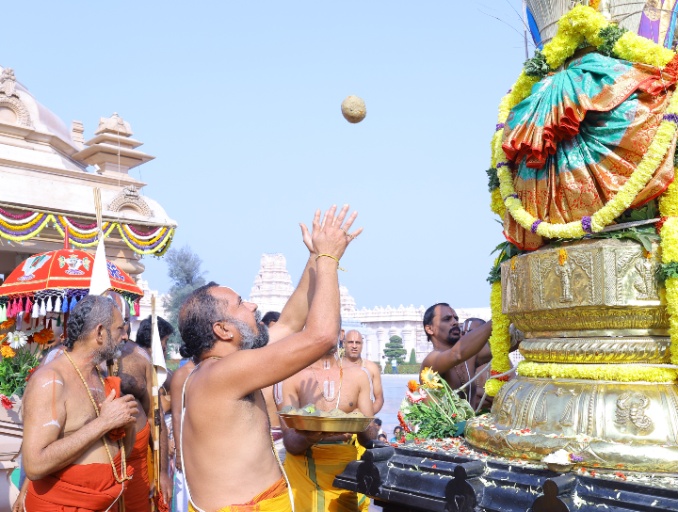
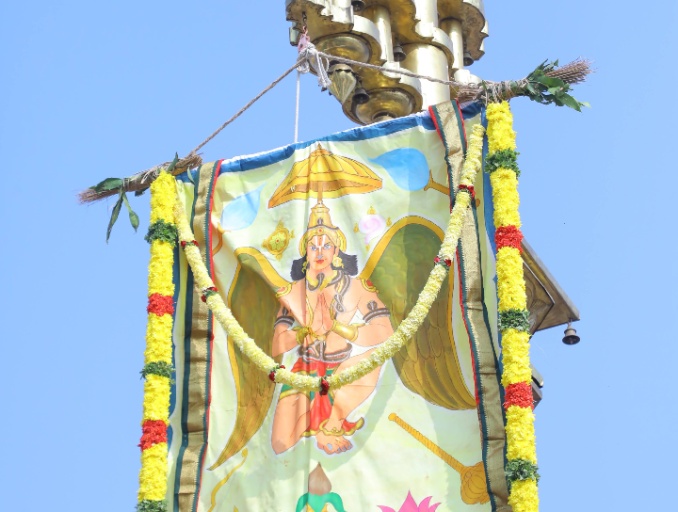
The agamas state the procedure by which the Garuda flag has to be hoisted at the beginning of Brahmotsavams. As part of this procedure, a special food offering is prepared. Agamas state that this prasadam has special powers of begetting ‘sat-santanam’. The couples who are desirous of having children consume this prasadam after worshipping. Many elders have experienced that such couples are blessed with progeny.
So it has become general practice that such couples look forward to getting that prasadam and in turn, grace of God. Garuda was very attached to his mother. To rid her of her servitude from Nagas, he overcame humongous obstacles and fetched Amrutham from Gods. He exchanged that amrutham with Nagas and set his mother free from the bondage. He blesses the couples with the boon of children.
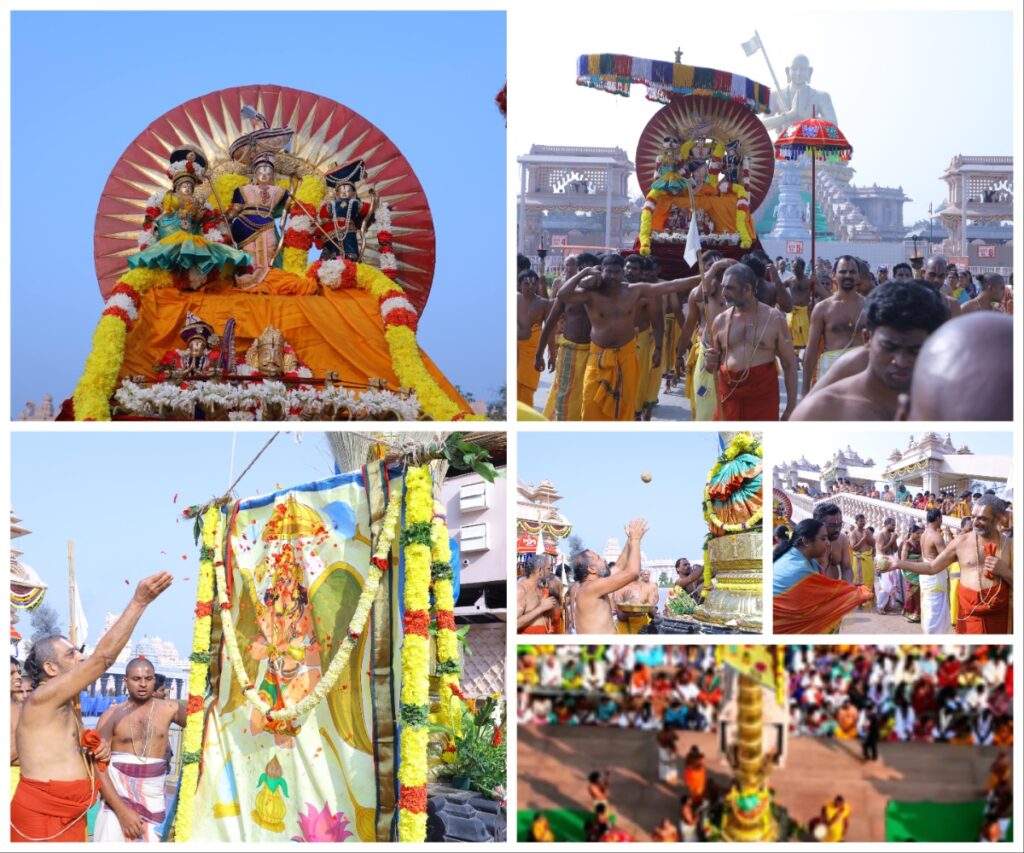
Nine homa kundams were prepared inside the yaga sala in various shapes as prescribed in the agamas.
The sacred fire for Brahomtsavams is lit by concentrating sun rays through magnifying lens (and not by churning the tree bark as done in other rituals).
Veda parayanam and chanting of other stotras has started in yagasala.
While the homams commenced at yaga sala, arrangements were going on at main stage for Gopalopayanam event.
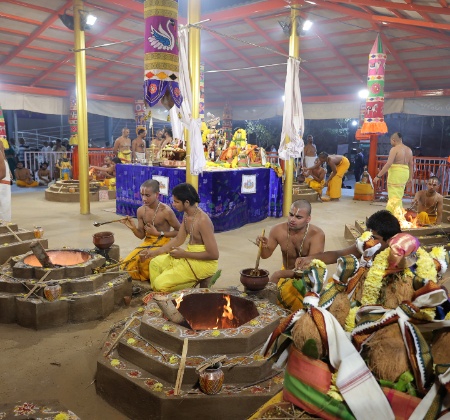
Homa kundams were prepared inside the yaga sala in various shapes as prescribed in the agamas
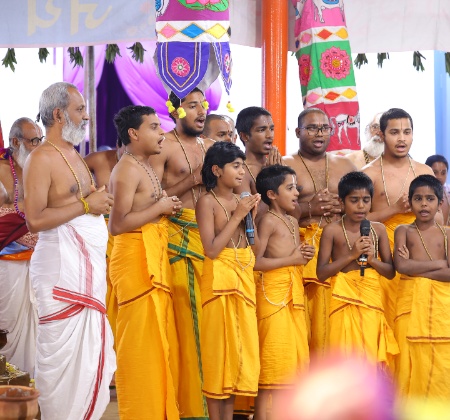
Veda Parayana in yaga sala
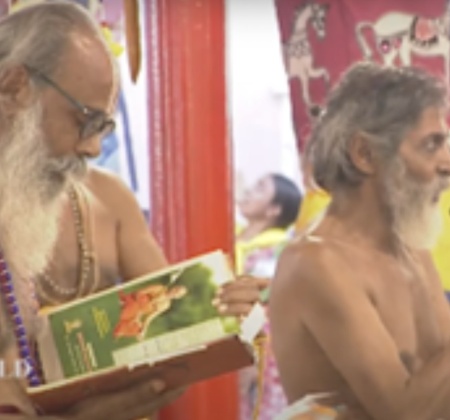
Chanting of Ramayana and scriptures
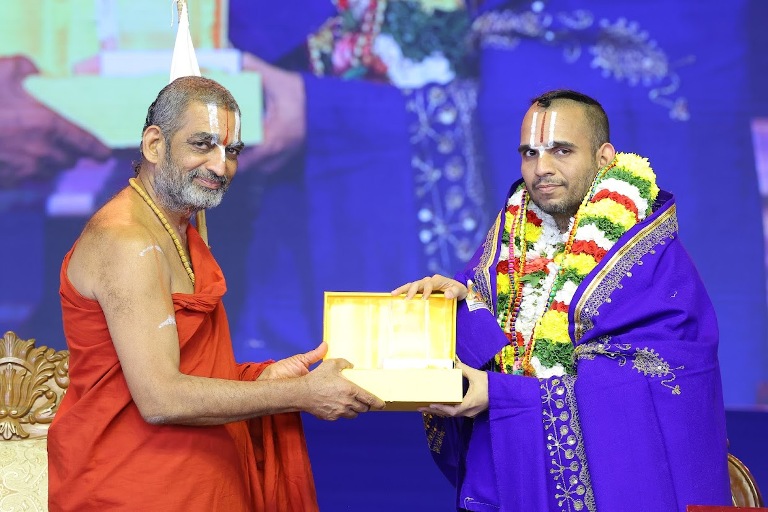
Gopalopayanam is an annual award conferred on a scholar who devoted his life towards spiritual literature – either Sanskrit Vedanta or Dravida Vedanta. It is given on the name of U. Ve. Telikicherla Kandadai Gopalacharya Swami. He is the acharya of our HH Chinna Jeeyar Swamiji.
This year marks the 32nd edition of this award.
The program got off to a start by lighting of lamp.
HH Chinna Jeeyar Swamiji gave an overview of life of his guru, Gopalacharya Swamiji.
Dr. Samudrala Ranga Ramanujacharya Swamiji gave an overview about the award. He too fondly recounted his own association with Sriman Gopalacharya Swamiji.
Sriman Nepal Krishnamacharya Swamiji introduced the award recipient for this year, Sriman U. Ve Mela Tirumaligai Ammaan Vishnuchittan Swami. He is the youngest recipient of this award, having born in 1985 in Tiru Vellarai near Srirangam. He did tremendous work in Ubhaya Vedantas and trained many more youngsters in the traditional knowledge. He has many disciples from all locations including North India. He teaches using online mediums too.
Sriman Vishnuchittan Swami received the award with humility and addressed the assembled devotees and scholars in English. He emphasized the importance of gaining knowledge from Acharyas in traditional mode of Kalakshepam (face-to-face by following the text) and not just superficially. It is important because our ancestors took lot of pains to preserve that knowledge till our turn came, braving many adversities in their life times.
For the benefit of devotees who could not understand English, HH Chinna Jeeyar Swamiji gave a gist of Vishnuchittan Swami’s speech in Telugu.
The day started in a serene atmosphere at about 6 AM, where the devotees, scholars and vedic students assembled for morning prayers and meditation.
HH Chinna Jeeyar Swamiji gave guided all the assembled folks on how we prepare for doing meditation.
We purify our body, indriyas and manas by our thoughts and then prepare to start the meditation. This purification process has been explained in our scriptures. We start with a sankalpam, sit in a comfortable posture, place our right palm on top of
After concluding the Gopalopayanam ceremony, the action shifted back to yaga sala.
Rutwiks performed Nithya Purnahuthi. Rutwiks, Swamijis and devotees performed Sala-pradakshina.
Veda Parayanas and chanting of scriptures were offered to Lord Rama.
Yagna prasadam was offered to devotees.
That concluded the morning sessions.
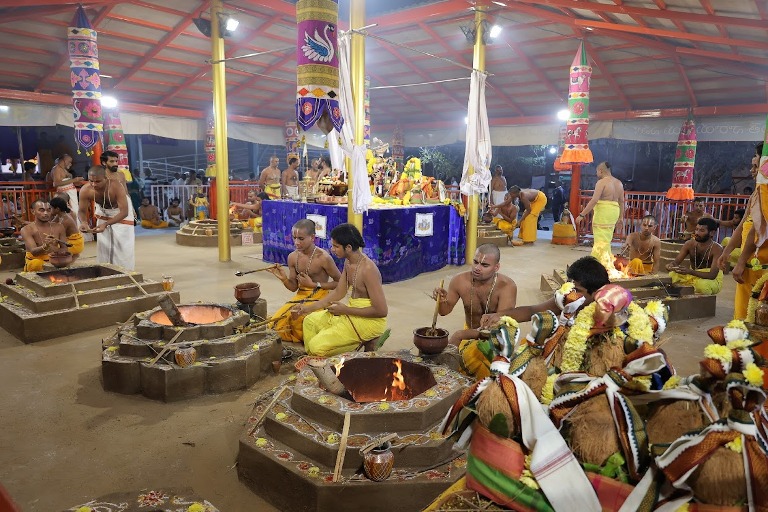
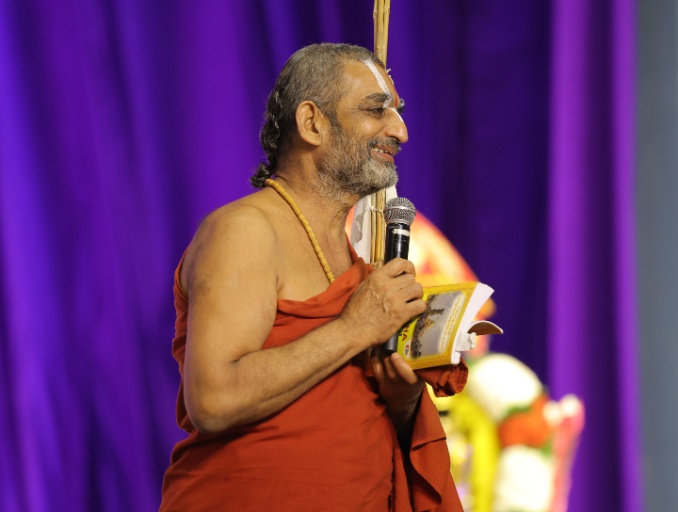
Swamiji explained the importance of Garuda sevas that we are about to witness today evening. We would have seen 9 Perumals converging at one place and being sung by Swami Nammalwar (Alwar Tiru Nagari). At Tirunangur divya desams, we would have witnessed eleven Perumals converging at one place and being offered managalasasanams by Swami Thiru mangai alwar. But this Statue of Equality is the only place where we have 18 Perumals coming on their Garuda vahanas and being worshipped by Swami Ramanuja, along with all of us. Another speciality is that the 18 Perumals who grace us with their Garuda sevas this evening accept our love in form of abhishekam next morning. So, we get a chance to witness 18 Thirumanjanams (abhishekams) at one place.
Lord Rama of Divya Saketam arrived at the venue on his Sesha-vahanam (serpent vehicle).
Swami Ramanuja on his hamsa vahanam was facing Lord Rama while fetching the Lord to venue. Thus, Ramanuja was walking backwards while watching Rama coming forward.
The Lords of first 18 divya desams arrived at the venue on their respective Garuda vahanams.
As each Lord was approaching the dais, HH Ahobila Jeeyar Swamiji was explaining the importance of each Divya Desam and how the Lord symbolizes spirit of equality.
Swami Ramanuja welcomed each of the 18 Lords at the venue respectfully.
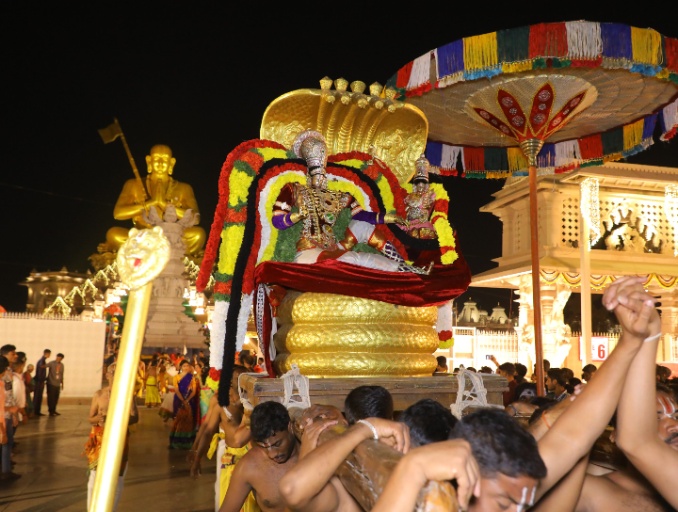
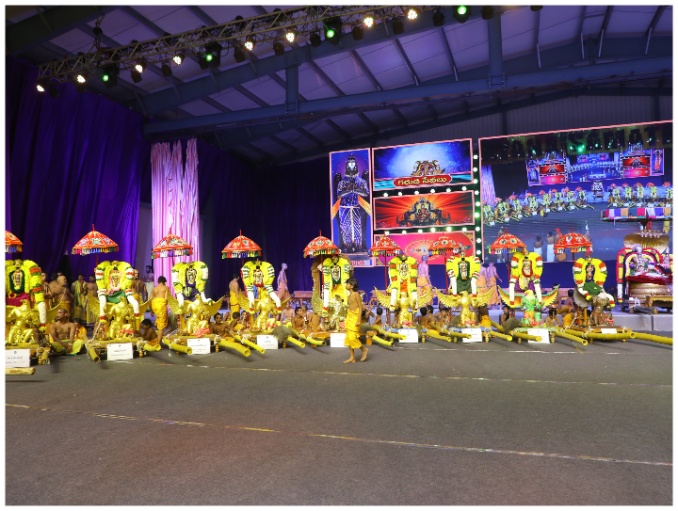
1 Srirangam / Om Sriranga kshetra nivasaya Sriranga nayaki sametaaya Sriranganathaya namaha
2 Thiru Uraiyur / Om Nichulapura nivasaya Vaasa Lakshmi sametaaya Sri Sundarajaa maatre namaha
3 Thiru Pullam Putam Gudi / Om Pullampooda pura nivasaya Hemambuja valli sametaaya Dhruddha chaapa dharaaya Sri Ramaya namaha
4 Thiru Anbil / Om Anbil pura nivasaya Sundara valli sametaaya Ujjwala Purna Sri Murthaye namaha
5 Thiru Karambanur / Om Sri Kadamba nagara nivasaya Purna valli sametaaya Sri Purushottamaaya namaha
6 Thiru Vellarai / Om Sitaadri nivasaya Champaka valli sametaaya Sri Pundarikaakshaaya namaha
7 Thiru Thanjamamani Koil / Om Thanjamamani Pura nivasaya Sri Ramyaabja valli priyaaya Sri Neelameghaaya namaha
8 Thirupper Nagar / Om Thirupper pura nivasaya Kamala valli sametaaya Sri Apoopa Priya Ranganaathaaya namaha
9 Thiru Peralandur / Om Alundoor pura nivasaya Semkamala valli sametaaya Sri Aamaruvi prabhave namaha
10 Thiru Aadanur / Om Aadanur pura nivasaya Sriranga nayaki sametaaya “Aandu alakkum Meyyan” aakhyaaya namaha
11 Thiru Siru Puliyur / Om Bala vyaghra pura nivasaya Sridevi sametaaya Sri Krupa Samudraaya namaha
12 Thiru Cherai / Om Saara Kshetra nivasaya Saara nayaki sametaaya Sri Saara naathaaya namaha
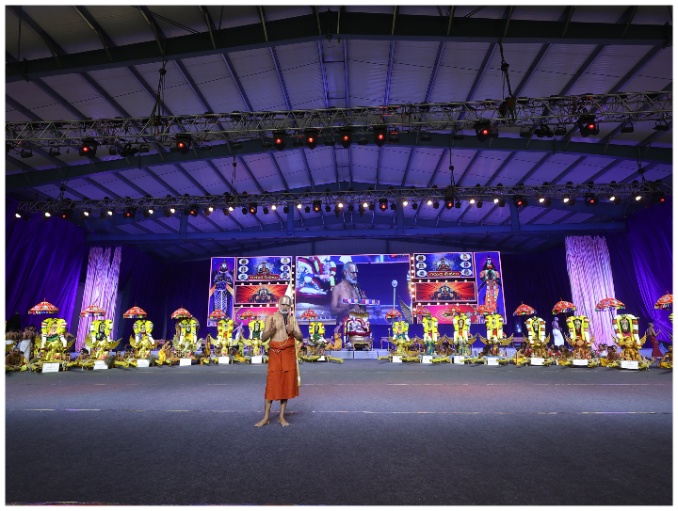
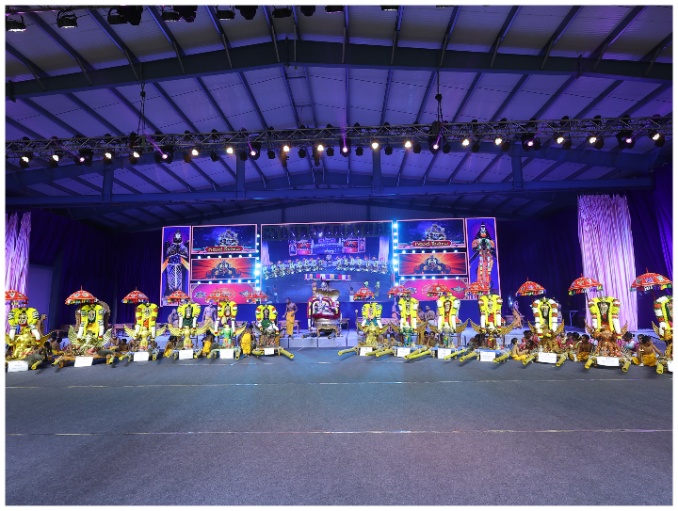
13 Thiru Thalai Chenga Nan madiyam / Om Sirassankha pura nivasaya Senkamala valli sametaaya Sri Vyoma Jyoti Swamine namaha
14 Thiru Kumbhakonam / Om Sri Kumbha Kona pura nivasaya Komala valli sametaaya Sri Athrupthamrutha Roopaaya namaha
15 Thiru Kandiyur / Om Sri Kandyur pura nivasaya Kamala valli sametaaya Sri Hara Saapa haraaya namaha
16 Thiru Vinnagaram / Om Sri Thiruvinnagar pura nivasaya Bhumi devi sametaaya Sri Anupama Srinivasaaya namaha
17 Thiruvali Thirunagari / Om Aalingana pura nivasaya Amrutha ghata valli sametaaya Sri Vayalaali Manavaalan Swamine namaha
18 Thiru Kanna puram / Om Sri Kanna pura nivasaya Kanna pura nayaki sametaaya Sri Bhoo Neelaa Godaa Sametaaya Sowri raajaaya namaha
The devotees who signed up for service of Garuda seva came up to the dais along with their respective Lords.
After all the 18 Lords were assembled, Swami Ramanuja went to each Lord and did mangalasasanam by singing the pasuram pertaining to that Lord. The Lord then greeted Ramanuja by gifting him sesha-vastram and Sri-Sathari. Swami Ramanuja gleefully accepts and then passed on to the devotees who signed up as sponsors for this service.
Swami Ramanuja then took Lord Rama and 18 Lords towards the yaga sala.
All of them proceeded to witness the day’s purnahuthi in yaga sala. After the Purnahuthi and mangalasasanam, the devotees proceeded to partake prasadam and return to their abodes with happy minds.
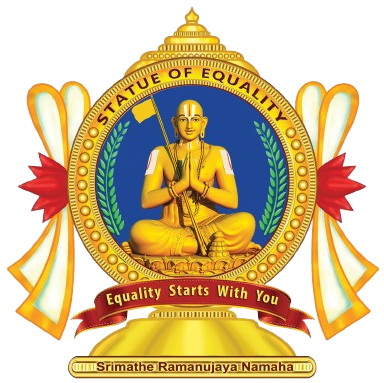
Stay Connected with Statue of Equality & Teachings of Sri Ramanujacharya